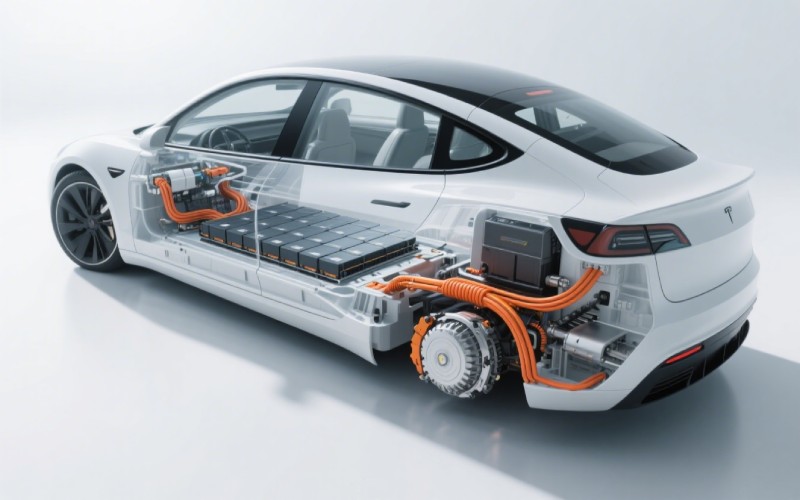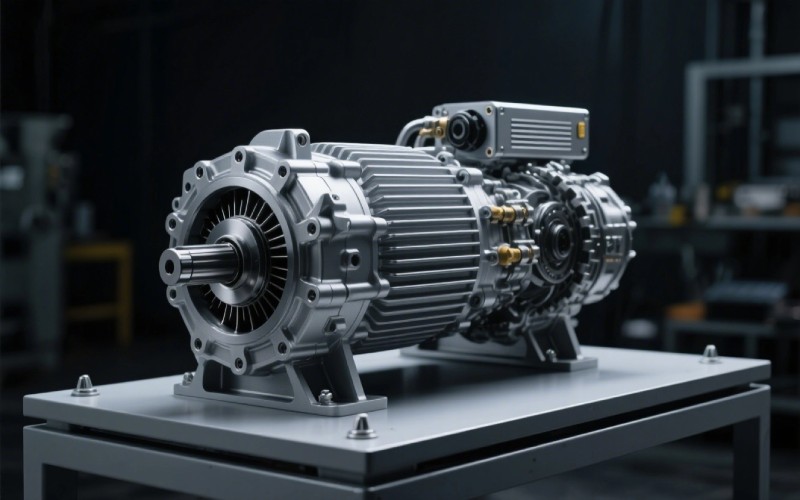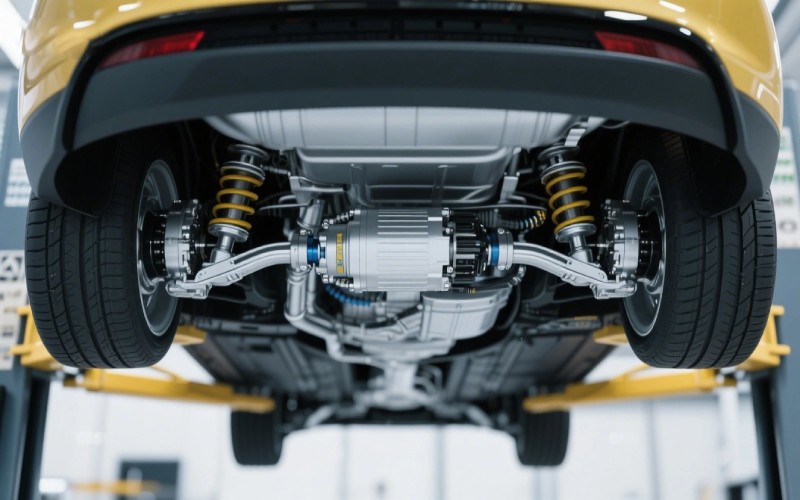Let Sino's Lamination Stacks Empower Your Project!
To speed up your project, you can label Lamination Stacks with details such as tolerance, material, surface finish, whether or not oxidized insulation is required, quantity, and more.

The words powertrain and drivetrain are often used as if they mean the same thing, but they don’t. In this article, I’m going to clear up the confusion for you. We’ll look at the difference between an EV powertrain and a drivetrain in simple, easy-to-understand language. Knowing this will help you understand how your electric vehicle really works. It will show you why your EV is so quiet and quick. And it will help you talk about your car with confidence. This is worth reading because it takes a confusing topic and makes it simple.
Let’s start with the big picture. Think of the powertrain as the heart and muscles of your car. The powertrain is responsible for creating all the power that makes your car move. It’s the entire system that makes energy and starts the process of getting your car down the road. These are the powertrain basics ought to be understood by every car owner.
In a gas car, or ICE vehicle, the powertrain is a long list of parts. It starts with the engine, of course. But it also includes the fuel tank, the fuel lines, the exhaust system, and the transmission. All these things work together to burn fuel and create power. The powertrain is made of many complex, moving components.
The powertrain refers to the complete set of components that generate power. The main job of the powertrain is to answer the question: “How do we make this car go?” The way power is created is the key job of the powertrain. It’s a complete system, from the energy source to the point where the power is ready to be sent out.
If the powertrain creates the power, what does the drivetrain do? The drivetrain is the delivery guy. Its only job is to take the power created by the powertrain and deliver it to the wheels. The drivetrain is what provides the connection between the power source and the ground. It doesn’t create any power itself. It just moves it.
Think of it like a bucket brigade. The powertrain is the person filling the buckets with water. The drivetrain is the line of people passing the buckets down to the fire. The drivetrain refers to the parts that get the power where it needs to go. This system of components is all about motion, not creation.
In any car, EV or gas, the drivetrain includes parts like the axle shafts and the differential. In many cars, it also includes a driveshaft. It’s a group of drivetrain parts that work together to make the wheels spin. The drivetrain’s job starts where the powertrain’s job ends.
I’ve found the easiest way to remember the difference between powertrain and drivetrain is to think about two simple words: “make” and “take.” The powertrain MAKES the power. The drivetrain TAKES that power to the wheels. That’s the core idea. The powertrain is the source. The drivetrain is the path.
The powertrain consists of everything needed to generate motive force. In an internal combustion engine vehicle, this means the engine, transmission, and more. In an EV, it’s the battery, inverter, and electric motor. The drivetrain includes the parts that come after that, like the axle and wheels. The difference between powertrain elements is huge depending on the type of car.
So, while the terms powertrain and drivetrain sound similar, they refer to different components with very different jobs. One is about the creation of energy, and the other is about the distribution of that energy. Understanding this simple split is the key to understanding your whole car, especially an EV. The drivetrain and powertrain work as a team, but they are not the same player.

This is where things get really interesting for us EV owners. The difference between an EV powertrain and a gas car’s powertrain is like the difference between a smartphone and a rotary phone. Both do the same basic job, but one is much simpler and more efficient. A traditional internal combustion engine has hundreds of moving parts. There are pistons, valves, spark plugs, and a complex exhaust system. The flywheel works with the transmission to smooth out power pulses from the engine. It’s noisy, it vibrates, and it needs a lot of maintenance.
An EV powertrain and drivetrain are much simpler. The powertrain includes just a few main parts: a battery pack, an inverter, and an electric motor. That’s it. There’s no oil to change in an engine, no spark plugs to replace, and no exhaust pipes to rust out. This simplicity is why electric vehicles are so reliable and quiet.
The job of the engine and the drivetrain in a gas car is to manage explosions. The job of the motor and the drivetrain in an EV is to manage the flow of electricity. This fundamental difference changes everything, from the feeling of acceleration to the cost of maintenance. The powertrain vs drivetrain debate is simpler in an EV, but the systems themselves are a revolution in car design.
When you look at an EV’s powertrain, you see elegant simplicity. The key components are few but powerful. First, you have the battery pack. This is the “fuel tank” of the EV. It stores electricity as direct current, or DC energy. It’s usually a large, flat pack located under the floor of the car, which helps with a low center of gravity.
Next is the inverter. This is the brain of the operation. The battery puts out DC power, but the electric motor in most electric vehicles needs alternating current, or AC power. The inverter’s job is to take the DC from the battery and change it into AC for the motor. It also controls the speed of the motor by changing the frequency of the AC power. This is how you control your speed when you press the accelerator pedal.
Finally, you have the electric motor itself. This amazing device is what turns electricity into motion. It’s small, light, and incredibly efficient. It is the most important part of the powertrain. When AC power flows through it, it creates a rotating magnetic field that spins the motor’s shaft. This rotation is the power that will eventually turn the wheels.
Once the electric motor creates rotational power, the drivetrain takes over. The parts of the drivetrain in an EV are also simpler than in a gas car. The first major part is often a single-speed transmission. Gas cars need multiple gears to keep the engine in its best power range. An electric motor makes strong power across a huge range of speeds, so most EVs only need one gear. This is a huge point of simplification. This single gear is sometimes called the final drive.
From the transmission, power goes to the differential. The differential is a clever set of gears that allows the wheels on the same axle to spin at different speeds. This is very important when you turn a corner. The outside wheel has to travel farther than the inside wheel, so it needs to spin faster. The differential makes this possible, providing smooth and stable turns.
Finally, the power goes from the differential out to the wheels through the drive axles, or half-shafts. At the ends of these axles are Constant Velocity, or CV joints. These special joints let the axle keep spinning at a constant speed even while the wheels are turning and moving up and down with the suspension. These drivetrain components are the final link to drive the wheels.

So, if they are so different, why does everyone get them mixed up? I think it comes down to two reasons. First, in a gas car, the engine and transmission are bolted together. They seem like one giant unit. Since the transmission is part of the powertrain but also directly connects to the drivetrain, the line gets blurry for many people. The terms ‘drivetrain’ and ‘powertrain’ get tangled up.
Second, in an EV, the systems are even more integrated. The electric motor, single-speed transmission, and differential are often packaged together in one compact unit. This unit takes electricity in one end and turns the axles on the other. Because it’s all in one box, it’s easy to just call the whole thing a powertrain or a drivetrain. Many times the terms ‘drivetrain’ and powertrain are used interchangeably because of this tight packaging.
But as we’ve learned, they are still separate systems doing separate jobs. The motor is creating power, making it part of the powertrain. The gears and differential are only delivering that power, making them part of the drivetrain. It’s a subtle but important distinction. The difference between powertrain elements and drivetrain parts is about function, not just location.
Every part we’ve talked about has a big impact on how your EV drives. The powertrain is what provides that instant torque that EVs are famous for. Because an electric motor makes its full power from a dead stop, you get thrilling acceleration the moment you touch the pedal. The inverter’s ability to precisely control the power delivery makes the car feel smooth and responsive.
The drivetrain also plays a huge role in handling and performance. The single-speed transmission means you get one long, smooth surge of power with no shifting. The differential helps you carve through corners with stability. In an all-wheel drive EV, you might have two motor-and-drivetrain units, one for the front axle and one for the rear. This allows for incredible traction and control in all driving conditions.
Together, the powertrains and drivetrains in an EV are designed for maximum efficiency and performance. There are fewer moving parts, which means less energy is lost to friction compared to an ICE vehicle. This is a big reason why EVs are so good at turning stored energy into movement, which improves range and lowers your “fuel” costs. To maintain optimal performance, these systems need to work in perfect harmony.
The magic of an EV is in how it creates motion, or propulsion. It’s a clean and quiet process. It all starts with the battery, which sends DC electricity to the inverter. The inverter converts this to AC electricity and sends it to the electric motor. This flow of electricity creates a magnetic field that forces the motor’s rotor to spin. This spinning is pure rotational energy.
This is where the drivetrain takes over. The motor’s spinning force is sent through the single-speed transmission to the differential. The drivetrain then transfers this torque from the transmission to the wheels via the axles. As the wheels turn, they push against the road, and your car moves forward. The car’s motion is a form of kinetic energy.
What’s amazing is that this process can also work in reverse. When you slow down, the wheels turn the motor. The motor then acts like a generator, turning the car’s kinetic energy into propulsion motion in reverse, creating electricity that goes back into the battery. This is called regenerative braking, and it’s a key part of what makes an EV so efficient. The power is created and distributed in a very smart loop.
You might be thinking, “This is interesting, but why do I need to know the drivetrain vs powertrain story?” I believe it matters a lot. First, it helps you be a smarter consumer. When you’re looking at different EV models, you’ll understand what it means when one has a more powerful motor or a more advanced drivetrain. You can make a better choice for your needs.
Second, it helps you understand what’s happening when you drive. You’ll appreciate that smooth, instant acceleration because you know it’s coming from an electric motor and a simple, direct drivetrain. You’ll understand why your EV is so quiet—because there are no explosions happening under the hood, just the quiet hum of electricity at work. The components that transfer power are much quieter.
Finally, it helps you talk with technicians and other EV owners. If you ever have an issue, you can describe it more accurately. You’ll know that a problem with acceleration might be in the powertrain, while a noise during turns might be in the drivetrain. Knowing the basics of how power is made and distributed to the car makes you a more empowered and confident owner. The powertrain elements and drivetrain components are the building blocks of your car.
To wrap it all up, here are the most important things to remember about the EV powertrain and drivetrain: